[English] 日本語
 Yorodumi
Yorodumi- PDB-2drn: Docking and dimerization domain (D/D) of the Type II-alpha regula... -
+ Open data
Open data
- Basic information
Basic information
| Entry | Database: PDB / ID: 2drn | ||||||
|---|---|---|---|---|---|---|---|
| Title | Docking and dimerization domain (D/D) of the Type II-alpha regulatory subunity of protein kinase A (PKA) in complex with a peptide from an A-kinase anchoring protein | ||||||
 Components Components |
| ||||||
 Keywords Keywords | TRANSFERASE / AKAP / PKA / signal transduction / 4-helix bundle / helix-loop-helix / protein-peptide complex | ||||||
| Function / homology |  Function and homology information Function and homology informationpositive regulation of meiotic cell cycle process involved in oocyte maturation / regulation of sarcomere organization / PKA activation in glucagon signalling / CREB1 phosphorylation through the activation of Adenylate Cyclase / DARPP-32 events / GPER1 signaling / Factors involved in megakaryocyte development and platelet production / Hedgehog 'off' state / PKA activation / cAMP-dependent protein kinase regulator activity ...positive regulation of meiotic cell cycle process involved in oocyte maturation / regulation of sarcomere organization / PKA activation in glucagon signalling / CREB1 phosphorylation through the activation of Adenylate Cyclase / DARPP-32 events / GPER1 signaling / Factors involved in megakaryocyte development and platelet production / Hedgehog 'off' state / PKA activation / cAMP-dependent protein kinase regulator activity / regulation of meiotic cell cycle process involved in oocyte maturation / nucleotide-activated protein kinase complex / MAP-kinase scaffold activity / cardiac muscle cell differentiation / regulation of Rho protein signal transduction / High laminar flow shear stress activates signaling by PIEZO1 and PECAM1:CDH5:KDR in endothelial cells / negative regulation of cAMP/PKA signal transduction / Vasopressin regulates renal water homeostasis via Aquaporins / germinal vesicle / regulation of small GTPase mediated signal transduction / cAMP-dependent protein kinase inhibitor activity / beta-2 adrenergic receptor binding / cAMP-dependent protein kinase complex / RHOB GTPase cycle / protein kinase A binding / NRAGE signals death through JNK / adrenergic receptor signaling pathway / positive regulation of Rho protein signal transduction / small molecule binding / RHOC GTPase cycle / protein kinase A catalytic subunit binding / plasma membrane raft / axoneme / RHOA GTPase cycle / cAMP binding / T-tubule / guanyl-nucleotide exchange factor activity / bone development / modulation of chemical synaptic transmission / small GTPase binding / adenylate cyclase-activating G protein-coupled receptor signaling pathway / G alpha (12/13) signalling events / heart development / cell cortex / molecular adaptor activity / positive regulation of canonical NF-kappaB signal transduction / G protein-coupled receptor signaling pathway / protein domain specific binding / synapse / ubiquitin protein ligase binding / centrosome / protein-containing complex binding / perinuclear region of cytoplasm / glutamatergic synapse / protein-containing complex / zinc ion binding / identical protein binding / nucleus / membrane / plasma membrane / cytoplasm / cytosol Similarity search - Function | ||||||
| Biological species |  | ||||||
| Method | SOLUTION NMR / simulated annealing | ||||||
 Authors Authors | Newlon, M.G. / Roy, M. / Morikis, D. / Hausken, Z.E. / Coghlan, V. / Scott, J.D. / Jennings, P.A. | ||||||
 Citation Citation |  Journal: Embo J. / Year: 2001 Journal: Embo J. / Year: 2001Title: A novel mechanism of PKA anchoring revealed by solution structures of anchoring complexes. Authors: Newlon, M.G. / Roy, M. / Morikis, D. / Carr, D.W. / Westphal, R. / Scott, J.D. / Jennings, P.A. | ||||||
| History |
|
- Structure visualization
Structure visualization
| Structure viewer | Molecule:  Molmil Molmil Jmol/JSmol Jmol/JSmol |
|---|
- Downloads & links
Downloads & links
- Download
Download
| PDBx/mmCIF format |  2drn.cif.gz 2drn.cif.gz | 427.8 KB | Display |  PDBx/mmCIF format PDBx/mmCIF format |
|---|---|---|---|---|
| PDB format |  pdb2drn.ent.gz pdb2drn.ent.gz | 361.2 KB | Display |  PDB format PDB format |
| PDBx/mmJSON format |  2drn.json.gz 2drn.json.gz | Tree view |  PDBx/mmJSON format PDBx/mmJSON format | |
| Others |  Other downloads Other downloads |
-Validation report
| Summary document |  2drn_validation.pdf.gz 2drn_validation.pdf.gz | 368.1 KB | Display |  wwPDB validaton report wwPDB validaton report |
|---|---|---|---|---|
| Full document |  2drn_full_validation.pdf.gz 2drn_full_validation.pdf.gz | 627.2 KB | Display | |
| Data in XML |  2drn_validation.xml.gz 2drn_validation.xml.gz | 26.5 KB | Display | |
| Data in CIF |  2drn_validation.cif.gz 2drn_validation.cif.gz | 43.7 KB | Display | |
| Arichive directory |  https://data.pdbj.org/pub/pdb/validation_reports/dr/2drn https://data.pdbj.org/pub/pdb/validation_reports/dr/2drn ftp://data.pdbj.org/pub/pdb/validation_reports/dr/2drn ftp://data.pdbj.org/pub/pdb/validation_reports/dr/2drn | HTTPS FTP |
-Related structure data
- Links
Links
- Assembly
Assembly
| Deposited unit | 
| |||||||||
|---|---|---|---|---|---|---|---|---|---|---|
| 1 |
| |||||||||
| NMR ensembles |
|
- Components
Components
| #1: Protein/peptide | Mass: 5398.181 Da / Num. of mol.: 2 Fragment: N-terminal docking and dimerization domain, residues 4-46 Source method: isolated from a genetically manipulated source Source: (gene. exp.)   #2: Protein/peptide | | Mass: 2533.828 Da / Num. of mol.: 1 / Source method: obtained synthetically Details: The peptide has been generated by solid phase peptide synthesis.; This sequence occurs naturally in humans. References: UniProt: Q14572, UniProt: Q12802*PLUS |
|---|
-Experimental details
-Experiment
| Experiment | Method: SOLUTION NMR |
|---|---|
| NMR details | Text: This structure was determined using standard 2d and 3d heteronuclear and homonuclear techniques. |
- Sample preparation
Sample preparation
| Details | Contents: 2mM RII-alpha(1-44); 90% H2O, 10% D2O / Solvent system: 90% H2O/10% D2O |
|---|---|
| Sample conditions | pH: 4 / Pressure: 1 atm / Temperature: 298 K |
-NMR measurement
| NMR spectrometer | Type: Bruker DMX / Manufacturer: Bruker / Model: DMX / Field strength: 500 MHz |
|---|
- Processing
Processing
| NMR software |
| ||||||||||||
|---|---|---|---|---|---|---|---|---|---|---|---|---|---|
| Refinement | Method: simulated annealing / Software ordinal: 1 Details: The structures are based on a total of 1370 restraints, 1247 are noe-derived distance restraints, 50 dihedral angle restraints,73 distance restraints from hydrogen bonds. | ||||||||||||
| NMR representative | Selection criteria: lowest energy | ||||||||||||
| NMR ensemble | Conformer selection criteria: structures with the lowest energy Conformers calculated total number: 50 / Conformers submitted total number: 13 |
 Movie
Movie Controller
Controller




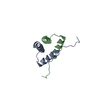


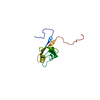
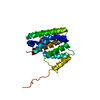
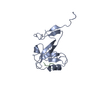

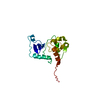
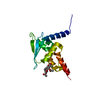
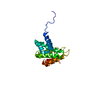
 PDBj
PDBj











 X-PLOR
X-PLOR